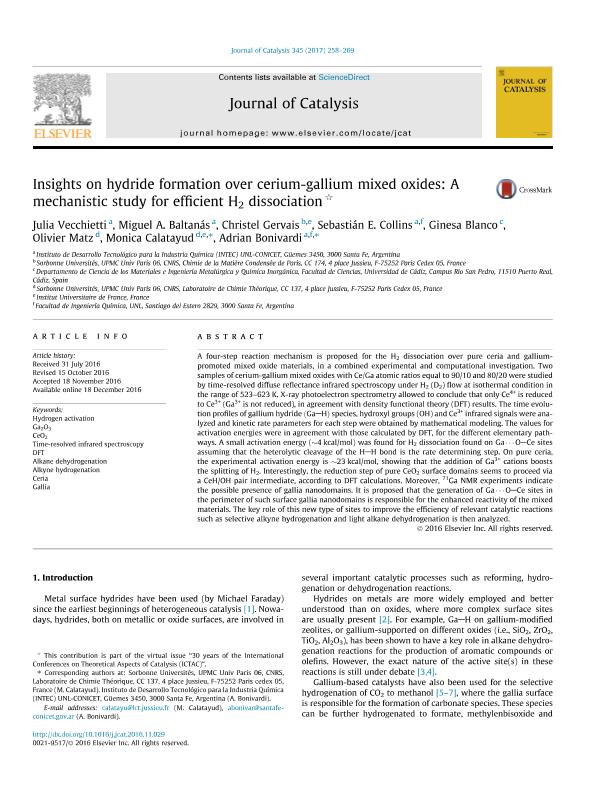Mostrar el registro sencillo del ítem
dc.contributor.author
Vecchietti, María Julia

dc.contributor.author
Baltanas, Miguel Angel

dc.contributor.author
Gervais, Christel
dc.contributor.author
Collins, Sebastián Enrique

dc.contributor.author
Blanco. Ginesa
dc.contributor.author
Matz, Olivier
dc.contributor.author
Calatayud, Monica
dc.contributor.author
Bonivardi, Adrian Lionel

dc.date.available
2017-07-14T14:45:34Z
dc.date.issued
2017-01
dc.identifier.citation
Vecchietti, María Julia; Baltanas, Miguel Angel; Gervais, Christel; Collins, Sebastián Enrique; Blanco. Ginesa; et al.; Insights on hydride formation over cerium-gallium mixed oxides: a mechanistic study for efficient H2 dissociation; Elsevier; Journal of Catalysis; 345; 1-2017; 258-269
dc.identifier.issn
0021-9517
dc.identifier.uri
http://hdl.handle.net/11336/20500
dc.description.abstract
A four-step reaction mechanism is proposed for the H2 dissociation over pure ceria and Gallium promoted mixed oxide materials, in a combined experimental and computational investigation. Two samples of cerium-gallium mixed oxides with Ce/Ga atomic ratios equal to 90/10 and 80/20 were studied by time-resolved diffuse reflectance infrared spectroscopy under H2 (D2) flow at isothermal condition in the range of 523?623 K. X-ray photoelectron spectrometry allowed to conclude that only Ce4+ is reduced to Ce3+ (Ga3+ is not reduced), in agreement with density functional theory (DFT) results. The time evolution profiles of gallium hydride ðGaAHÞ species, hydroxyl groups (OH) and Ce3+ infrared signals were analyzed and kinetic rate parameters for each step were obtained by mathematical modeling. The values for activation energies were in agreement with those calculated by DFT, for the different elementary pathways. A small activation energy (4 kcal/mol) was found for H2 dissociation found on GaOCe sites assuming that the heterolytic cleavage of the HAH bond is the rate determining step. On pure ceria, the experimental activation energy is 23 kcal/mol, showing that the addition of Ga3+ cations boosts the splitting of H2. Interestingly, the reduction step of pure CeO2 surface domains seems to proceed via a CeH/OH pair intermediate, according to DFT calculations. Moreover, 71Ga NMR experiments indicate<br />the possible presence of gallia nanodomains. It is proposed that the generation of Ga OACe sites in the perimeter of such surface gallia nanodomains is responsible for the enhanced reactivity of the mixed materials. The key role of this new type of sites to improve the efficiency of relevant catalytic reactions such as selective alkyne hydrogenation and light alkane dehydrogenation is then analyzed.
dc.format
application/pdf
dc.language.iso
eng
dc.publisher
Elsevier

dc.rights
info:eu-repo/semantics/openAccess
dc.rights.uri
https://creativecommons.org/licenses/by-nc-sa/2.5/ar/
dc.subject
Hydrogen Activation
dc.subject
Catalysis
dc.subject
Surfaces
dc.subject
Infrared
dc.subject.classification
Otras Ciencias Químicas

dc.subject.classification
Ciencias Químicas

dc.subject.classification
CIENCIAS NATURALES Y EXACTAS

dc.title
Insights on hydride formation over cerium-gallium mixed oxides: a mechanistic study for efficient H2 dissociation
dc.type
info:eu-repo/semantics/article
dc.type
info:ar-repo/semantics/artículo
dc.type
info:eu-repo/semantics/publishedVersion
dc.date.updated
2017-07-10T13:10:26Z
dc.journal.volume
345
dc.journal.pagination
258-269
dc.journal.pais
Países Bajos

dc.journal.ciudad
Amsterdam
dc.description.fil
Fil: Vecchietti, María Julia. Consejo Nacional de Investigaciones Científicas y Técnicas. Centro Científico Tecnológico Conicet - Santa Fe. Instituto de Desarrollo Tecnológico para la Industria Química. Universidad Nacional del Litoral. Instituto de Desarrollo Tecnológico para la Industria Química; Argentina
dc.description.fil
Fil: Baltanas, Miguel Angel. Consejo Nacional de Investigaciones Científicas y Técnicas. Centro Científico Tecnológico Conicet - Santa Fe. Instituto de Desarrollo Tecnológico para la Industria Química. Universidad Nacional del Litoral. Instituto de Desarrollo Tecnológico para la Industria Química; Argentina
dc.description.fil
Fil: Gervais, Christel. Universite de Paris VI; Francia
dc.description.fil
Fil: Collins, Sebastián Enrique. Consejo Nacional de Investigaciones Científicas y Técnicas. Centro Científico Tecnológico Conicet - Santa Fe. Instituto de Desarrollo Tecnológico para la Industria Química. Universidad Nacional del Litoral. Instituto de Desarrollo Tecnológico para la Industria Química; Argentina
dc.description.fil
Fil: Blanco. Ginesa. Universidad de Cádiz; España
dc.description.fil
Fil: Matz, Olivier. Universite de Paris VI; Francia
dc.description.fil
Fil: Calatayud, Monica. Universite de Paris VI; Francia
dc.description.fil
Fil: Bonivardi, Adrian Lionel. Consejo Nacional de Investigaciones Científicas y Técnicas. Centro Científico Tecnológico Conicet - Santa Fe. Instituto de Desarrollo Tecnológico para la Industria Química. Universidad Nacional del Litoral. Instituto de Desarrollo Tecnológico para la Industria Química; Argentina
dc.journal.title
Journal of Catalysis

dc.relation.alternativeid
info:eu-repo/semantics/altIdentifier/doi/http://dx.doi.org/10.1016/j.jcat.2016.11.029
dc.relation.alternativeid
info:eu-repo/semantics/altIdentifier/url/http://www.sciencedirect.com/science/article/pii/S0021951716302834?via%3Dihub
Archivos asociados
